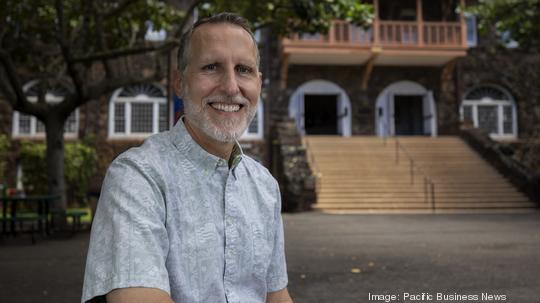
Paul Turnbull, the ninth president of Mid-Pacific, believes in utilizing artificial intelligence technologies to help “future-proof” students, or prepare them for the jobs of tomorrow. Pacific Business News caught up with the president of the college preparatory school on how he believes teachers, students and other industries can incorporate AI into their work.
How can workers utilize artificial intelligence to their advantage? AI technologies can significantly increase productivity if applied in the right way. At Mid-Pacific, we have offered workshops for our employees and parents, helping them to familiarize themselves with generative AI tools and focusing on understanding how to use these tools to automate routine tasks. For example, administrative staff can use generative AI to improve scheduling, customer outreach and annual planning processes, as well as adding a new dimension to on-the-job learning via personalized assistants. ChatGPT can create the framework of a report, it can help to analyze data and provide visualizations for reporting, and it can help to edit written documents. Each of those tasks can help employees save time, allowing them to focus on higher-order tasks.
In what ways can teachers and students incorporate AI while maintaining academic integrity? At Mid-Pacific we view AI not as a threat, but as a powerful tool and potential collaborator in the learning process and in our support offices. We encourage teachers, students and support staff to experiment with AI. We believe that with enough practice and guidance, AI can stimulate creativity, help people to generate new ideas, and increase productivity with routine tasks such as high volume email responses, spreadsheet calculations, co-creation of meeting agendas and action plans, and much more. In each case, the goal is to maintain one’s unique voice and thought process while using a chatbot to provide personalized assistance.
In the classroom context, generative AI could help a student structure an essay or generate ideas around a topic while students remain responsible for building upon the initial AI-generated outputs. Students should know how to critically evaluate those outputs, integrate their own thoughts, perspectives and insights, while demonstrating how the final essay represents the collaborative tool and the student’s individual voice. This approach not only maintains academic integrity but also promotes a higher level of cognitive and writing skills. It’s about using AI to enhance the students’ abilities and foster an advanced understanding, rather than outsourcing their academic work to technology. By interacting with AI in this manner, students are developing a skill set that will be invaluable in the future, where AI and humans will increasingly work in tandem.
Tell me a little about how you are “future-proofing” students for the technological landscape of the future? The Mid-Pacific Technology Vision is driven by an essential question: “How can technology enhance the human experience, not drive it?” Starting in the elementary grades, we provide students access to an immersive technology program that hosts computer programming, robotics, 3D scanning, game design, 3D animation for virtual reality/augmented reality, and cyber security. Additionally, many teachers began experimenting with the addition of generative AI tools across academic disciplines in early January.
However, we believe that truly preparing students for the future requires more than just providing amazing technological tools. We help students understand the underlying concepts and potential implications of technology, and we celebrate a deeper learning model that asks students to actively use collaboration, communication, creativity, networking and higher-order problem-solving skills. Most importantly, we emphasize adaptability and the ability to learn and relearn throughout life. Given the pace at which technology is advancing, the ability to keep learning and adapting is no longer an option; it’s a necessity.






